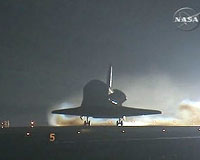 |
London, UK (SPX) Apr 26, 2011 Technology developed for space missions to study the most distant objects in the Universe is now finding a host of practical applications back on Earth. QMC Instruments Ltd., in partnership with the Astronomical instrumentation Group at Cardiff University, has built instruments for many major space missions, including Herschel and Planck. Now, expanding on that experience they are developing KIDCAM, a kind of detector that could have applications in hospitals, factories and airports. Ken Wood will present the project at the RAS National Astronomy Meeting in Llandudno, Wales. The part of the Electromagnetic Spectrum including the far infra red and microwave is also called 'terahertz' radiation. Astronomers use this kind of radiation to study the Cosmic Microwave Background and the huge dust clouds where stars are born. The sensitive detectors they use will only operate at temperatures very close to absolute zero (minus 273C.) In Terahertz cameras like KIDCAM, those low temperatures are accessible in compact and less expensive ways using relatively new cooler technology. KIDCAM therefore has many potential day-to-day applications. "We are all familiar with optical images of the surface of objects and X-ray images which penetrate through soft tissue to reveal bone structure. Terahertz observations give us something in between the two. For example, most clothing and packaging materials are transparent to Terahertz radiation, whereas skin, water, metal and a host of other interesting materials are not. This gives rise to some important day-to-day applications: detecting weapons concealed under clothing or inside parcels; distinguishing skin and breast cancer tissue; quality control of manufactures items and processes in factories. Our KIDCAM detectors are also very sensitive, and so we can look at the natural radiation emitted by the target. This means there are no safety issues like those associated with other imaging techniques which shine radiation, including X-rays, at the target," said Wood. Until recently, there have been many practical obstacles to using terahertz detectors. Terahertz sources have only become available to the non-specialist in the last 10 years and cooling the detectors to very low temperatures using liquid cryogens is costly and complicated. "The instruments aboard the Herschel and Planck satellites need to be cooled to temperatures close to absolute zero so that emissions from the spacecraft don't drown out the faint signals that come from the very edge of the observable Universe," said Ken Wood. "For KIDCAM, we have developed a kind of detector that can be operated in electrical coolers and therefore without the use of liquified gases. KIDCAM can be tuned to specific frequencies for specific applications, for instance to enhance the contrast between skin and plastic explosive for airport security scanners. Unwanted frequencies can be blocked to increase the camera's sensitivity. The experience that we gained working on astronomical missions has been invaluable in helping us do this. The race is now on around the world to produce devices that will realise the enormous potential of terahertz science and thanks to the ingenuity of UK astronomers we have made a great start."
Share This Article With Planet Earth
Related Links Royal Astronomical Society The latest information about the Commercial Satellite Industry
 USA Announces End-Of-Program Workforce Reduction
USA Announces End-Of-Program Workforce ReductionHouston TX (SPX) Apr 19, 2011 United Space Alliance has announced that, following the final mission of the Space Shuttle Program, the company will implement a major workforce reduction in late July and early August due to the completion of tasks related to day-to-day operations of the Shuttle fleet. Two missions remain in the Space Shuttle Program - STS-134 currently scheduled for April 29, 2011, and STS-135, which is ... read more |
|
| The content herein, unless otherwise known to be public domain, are Copyright 1995-2010 - SpaceDaily. AFP and UPI Wire Stories are copyright Agence France-Presse and United Press International. ESA Portal Reports are copyright European Space Agency. All NASA sourced material is public domain. Additional copyrights may apply in whole or part to other bona fide parties. Advertising does not imply endorsement,agreement or approval of any opinions, statements or information provided by SpaceDaily on any Web page published or hosted by SpaceDaily. Privacy Statement |